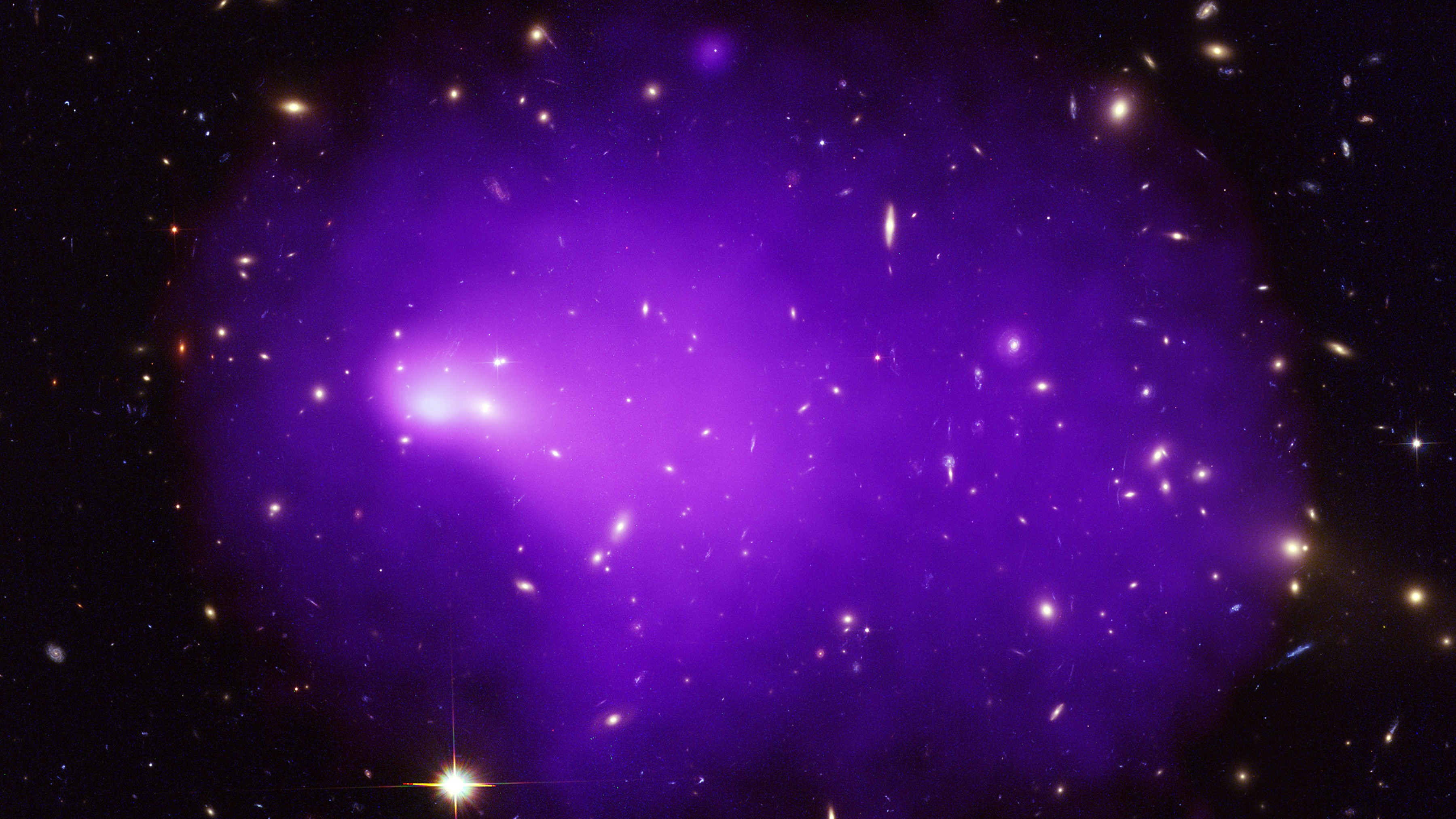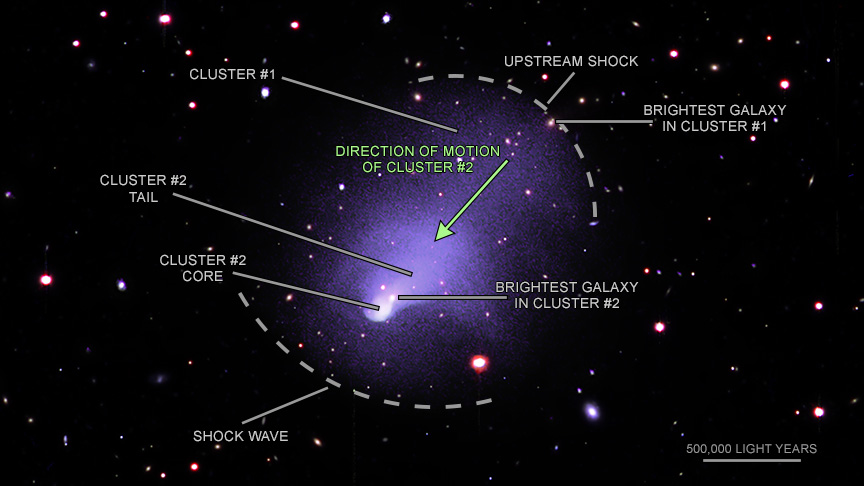Giant galaxy cluster collision triggers vast shock wave stretching over a million light-years long
The clash of two galaxy clusters in Abell 2146 is teaching astronomers about the kinds of "collisionless" shock waves that occur in our own solar system.
Two giant galaxy clusters crashing into each other triggered enormous shock waves stretching 1.6 million light-years through space.
The findings, revealed by NASA's Chandra X-ray Observatory, are helping astronomers better understand the powerful processes at work in collisions between clusters of thousands of galaxies.
Galaxies make up only a small percentage of the total mass of a galaxy cluster. The majority consists of an immense halo of dark matter and a cloud of hot, diffuse gas called the intra-cluster medium that envelops the galaxies in the cluster. Because the gas is so hot, radiating at hundreds of millions of degrees Celsius, it shines brightly in X-rays.
Related: What's it like inside a massive galaxy cluster? Scientists used 196 lasers to find out

When two clusters come into contact, the individual galaxies slide harmlessly past each other, but the gas of the intra-cluster medium undergoes a far more energetic encounter, generating vast shock waves.
The particular cluster collision studied here by Chandra, Abell 2146, is located 2.8 billion light-years away. It's one of only three cluster collisions in the universe where the shock fronts are bright enough to be studied in detail. (The other two are the Bullet Cluster and Abell 520.)
A team led by Helen Russell, an astronomer at the University of Nottingham in the U.K., used Chandra to observe Abell 2146 for a total of 23 days — the deepest look at a cluster's shock waves ever undertaken.
Get the Space.com Newsletter
Breaking space news, the latest updates on rocket launches, skywatching events and more!
One of the clusters is falling through the other one. As it does so, it generates two shock waves: a "bow shock" at its leading edge (like at the prow of a boat moving through water) and an "upstream shock" behind it.
The bow shock has a simple explanation: Gas is compressed ahead of the infalling cluster as it passes through. The upstream shock is a little more complex, and forms when gas that's removed from the infalling cluster — in a process known as "ram-pressure stripping" — is left behind and interacts with the in situ gas in the cluster that it is moving through.

Russell's team measured not only the length of these shocks — 1.6 million light-years long, in the case of the main bow shock — but also, for the first time, their width. Theory predicts that the upstream shock should be narrower because it is younger, having formed after the bow shock. This is indeed what Chandra discovered, measuring the depth of the bow shock to be 55,000 light-years wide and the upstream shock to be about 35,000 light-years wide.
Using Chandra, Russell's team measured the energy of the gas (which we might loosely think of as its temperature) in the upstream shock as rising from 6 to 8 kilo-electron volts. The gas seems to have obtained this energy primarily by the compression effect of the shock wave energizing electrons in the gas. Crucially, collisions between individual atoms and molecules are rare, because the gas is very diffuse.
Chandra measured the random motion of particles in the intra-cluster medium as being about 290 kilometers per second (650,000 mph), and those particles can travel up to 50,000 light-years, on average, before they encounter another particle. So, although Chandra measured some secondary heating from particle collisions, this heating must have happened slowly, building up over 200 million years.
The confirmation that most of the heating in a galaxy cluster collision is through "collisionless" shocks allows comparisons to be drawn with events on a much smaller scale, here in our own solar system. The solar wind, for example, experiences collisionless shocks when it encounters an obstacle such as Earth, and these shocks can disturb the planet's magnetic field and accelerate charged particles to instigate a geomagnetic storm. By comparing the creation of these collisionless shocks on vastly different scales, scientists may gain further insight into the physics of how the shocks in cluster collisions, as well as those in solar and stellar winds, take place.
The findings have been accepted for publication in the journal Monthly Notices of the Royal Astronomical Society, and a preprint is available via the arXiv database.
Follow Keith Cooper on Twitter @21stCenturySETI. Follow us on Twitter @Spacedotcom and on Facebook.
Join our Space Forums to keep talking space on the latest missions, night sky and more! And if you have a news tip, correction or comment, let us know at: community@space.com.

Keith Cooper is a freelance science journalist and editor in the United Kingdom, and has a degree in physics and astrophysics from the University of Manchester. He's the author of "The Contact Paradox: Challenging Our Assumptions in the Search for Extraterrestrial Intelligence" (Bloomsbury Sigma, 2020) and has written articles on astronomy, space, physics and astrobiology for a multitude of magazines and websites.









